In Jan Miense Molenaer’s “The Smoker” from the 1620′s, viewers have an up-close regard on merrymakers, where children are inserted as metaphors for adult behavior. There is a capturing of the spirit of the figures through actions and facial expressions.The energy and high spirits of children allowed adults to delight in the escapades; children will be children and boys will be boys. The children in Molenaer’s work seem to involve themselves readily in behavior typically constructed around adult sinners: puffing, boozing, gambling, carousing, skirt-chasing, and and a bit of rough and tough. The girl may follow through on her intention to smack her neighbor with the footwear she grips. It all suggests that this extreme behavior, caricaturized as it is, in obvious mocking poses, uses the incongruity of children to pass a message to adults that touched directly on issues relevant to the grown-up world.
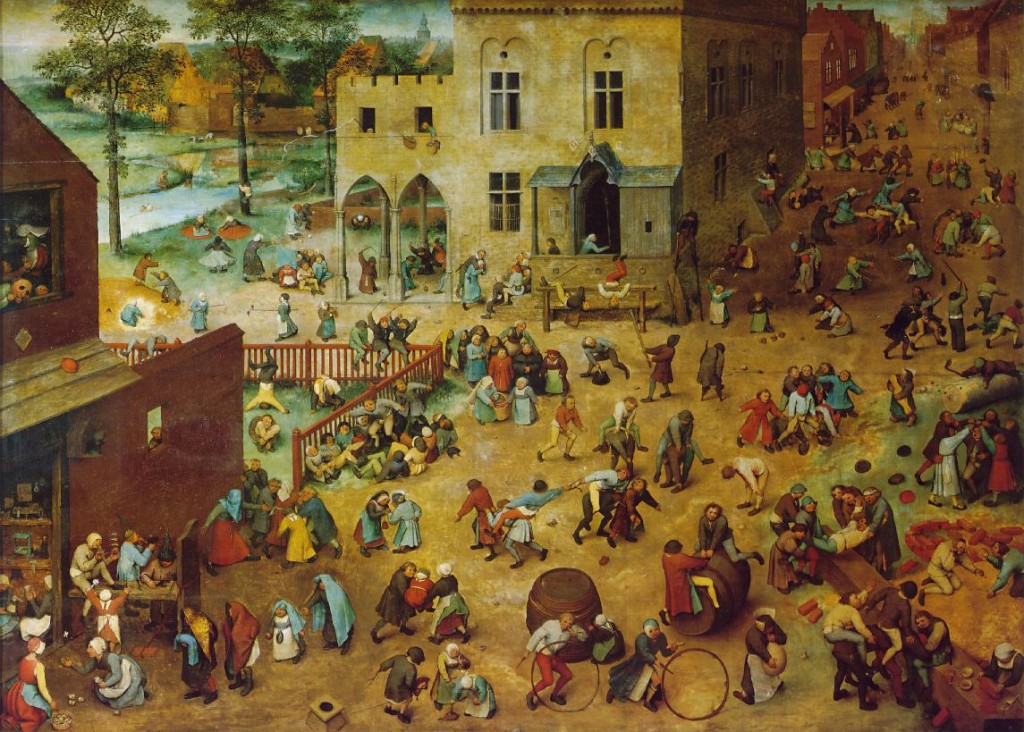
"Flemish painter, Pieter Bruegel the Elder, painted "Children's Games" in 1560. While many of his other paintings also portray peasant folk culture, this summer townscape that is devoid of adults is rich in detail about Medieval children—especially at play. The painting provides a window into amusements and recreations in the past in its detailed depiction of some 200 children engaged in nearly 80 different games and play activities. Many (although not all) of the outdoor activities included in this visual compendium of 16th-century children's play will be recognizably familiar. Physically energetic and imaginatively engaged girls and boys are everywhere in Bruegel's busy painting. Some are using their bodies, others are playing with children and/or with toys (e.g., windmill; hoops). Here are some examples. Three boys mounted on a red fence are pretending to race horses. A few are playing leapfrog and others playing "horsey" and "tug of war." Another is straddling a hobbyhorse. Two girls are playing a medieval form of jacks (knucklebones) but with a bone instead of a ball...." Read More: http://chnm.gmu.edu/cyh/primary-sources/332
The use of children as reflections of adult behavior went further back before Molenaar, at least to the sixteenth-century when Pieter Bruegel cast a regard on adult madness in Children’s Games. In addition to Molenaar, Jan Steen also used the motif based on the common conception that children will tend to copy, even parrot, the social patterns of their elders, which became a common theme for Dutch and Flemish artists of the Golden Age.Even then, underneath the shiny innocence of the child lay a darker side…
Depictions of children, are often obscure and more complex than most viewers are ready to admit. They are not so much about innocence as they are about the techniques we use to manufacture innocence and project it. For innocence is a human creation; a narrative we tell about ourselves, not something we actually are.Its a process of being without arriving anywhere, a for of disavowal through a mediated image. While we often think of innocence as a given;a state of refelction as infants and that vanishes as we grow older:this view is a relatively recent one, largely a product of the nineteenth century, which fostered a sentimental cult of the child as a defense against taboos such as incest and other forms of abuse.
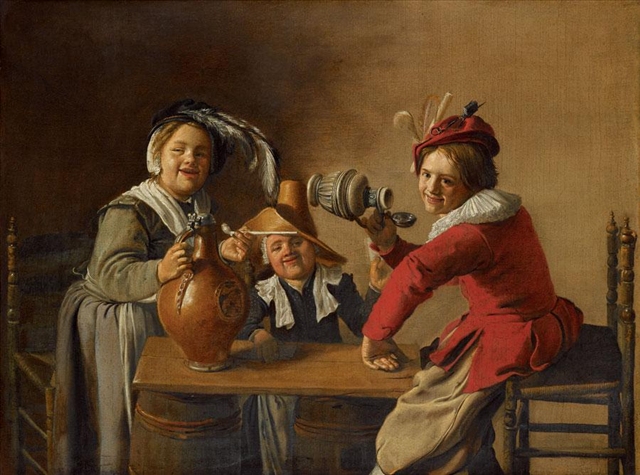
Molenaer depicted several series of the Five Senses throughout his career besides these two farcical series. These include a series of panels depicting half-length children (c. 1628-29) which owe much to examples produced by Frans and Dirck Hals in Haarlem....Read More: http://www.caans-acaen.ca/Journal/issues_online/Issue%20XXVIII_2007/Schiller2007.pdf image: http://www.artnet.com/artists/lotdetailpage.aspx?lot_id=C3C0E0017E28BFDA9434B76908E6A469
So,its evident that using children as the subject of art work is not a modern phenomenon; even the contradictory qualities of fascination and disquiet have been elaborated before, albeit less graphically, though it appears that art involving the manipulation of young children seems more prevalent today which has brought up the issue of a child’s rights, ethics etc. An example is the photo blog, “While The Baby Sleeps” by a mother from Finland,Adele Enersen who poses her newborn in various imaginary landscapes.

"But Enersen’s photos aren’t typical new-mom pics. Instead, the designer uses pillows, Pashminas, books, balls and balloons to create elaborate dreamscapes around her sleeping bambina. "While my baby is taking her nap, I try to imagine her dream and capture it," Enersen explains. In one shot Mila is a (snoozing) surfer chick catching a gnarly wave; in the next she’s a (napping) astronaut orbiting some faraway galaxy. In her short little life, Mila’s played a circus juggler, rock star, mermaid, bunny, butterfly, bat-baby and more -- and her imaginative mom has the photos to prove it. The blog is clever and whimsical and I particularly enjoy the way Enersen incorporates Mila’s conked-out postures into her designs. Read More http://www.ivillage.com/blog-were-obsessed-milas-daydreams/6-a-232144#ixzz1GIcyKRaJ Sign up for iVillage Special Offers" Read More: http://www.ivillage.com/blog-were-obsessed-milas-daydreams/6-a-232144
More reflective of the more obscure corners of our culture is what rubs against the grain of shock, memory; the Baudelaire and Walter Benjamin conception that survival within a capitalist society is barely attained if not a shock reception, which has to be mediated:
Saftich: “And so Baudelaire introduced experience in terms of shock as the heart of his artistic endeavor. More so, it was he who learned to parry the blows, enabling existence for himself and others despite the earthquake cancelling out that possibility. Thus, Benjamin arrived at the conclusion of the people’s loss of experience in a highly developed society as well as the substitution of that lost experience by shock reception. In modern society, in other words, the increasing number of blows in place of individual defense mechanisms, there has raised a series of mechanical replacements that, although they shield us partially, also strip us of the possibility to understand and assimilate that which is really happening. In that sense, media also acts as an anesthetic against the blow of novelty, Grlic writes: If shock can be accepted, experience will occur after all. However, as consciousness is mostly preoccupied with defending against the blow, repulsion of stress, experience related material is suppressed into the unconsciousness. Experiences lived through allow us to rationally elaborate life’s shocks and defend our consciousness from their attack and deeper permeation. In that sense, experience is simply the immediate result of shock, lacking any medium:

"Danish-Norwegian artist Nina Maria Kleivan made a series of tiny uniforms to dress her daughter up as Joseph Stalin, Benito Mussolini, Saddam Hussein, Ayatollah Khomeini, Chairman Mao, Idi Amin, Augusto Pinochet, Slobodan Milosevic. Dressing her as Adolf Hitler, she also paints a moustache on her. She said her aim was simple: to show that everyone begins life the same and all have to same opportunities ahead of us to do good or evil. "We all have evil within us. Even small children are evil towards each other," Kleivan told the Israeli newspaper Haaretz. "Even my daughter could end up ruling Denmark with an iron fist. The possibility is still there. You never know." She said that while reactions had been mixed, people particularly took offence to the Hitler picture. Her own father was held in a Prisoner of War camp. " Read More: http://www.telegraph.co.uk/culture/art/art-news/7470960/Mother-causes-fury-dressing-daughter-up-as-Hitler.html
this is the case of Baudelaire who repeatedly experiences blows caused by the passing masses, the lights of the metropolis and other situations typical for the life of a modern city. The philosophical and esthetic value of Baudelaire’s poetry lays the fact that he ele
d the experience of shock reception to an esthetic principle.( Saftich )ADDENDUM:
Read More:http://www.caans-acaen.ca/Journal/issues_online/Issue%20XXVIII_2007/Schiller2007.pdf a
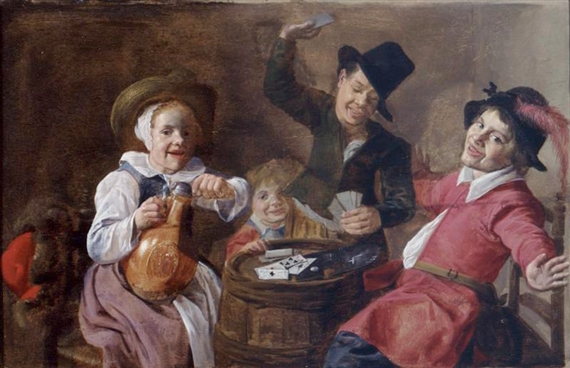
"CHILDREN PLAYING CARDS AROUND A BARREL" Read More: http://www.mutualart.com/Artwork/CHILDREN-PLAYING-CARDS-AROUND-A-BARREL/8C69A2A5410C4DA4?Promo=6DCF268F9D06D1DA
The concept of experience, as the reception of a blow, notes Grlic, is what Benjamin tried to render plausible through one of Freud’s hypotheses: consciousness’ primary function is not accepting stimuli, but attaining protection from stimuli. Accepting Freud’s differentiation between unconscious memory and the conscious act of recollecting, Benjamin, as interpreted by Baudelaire, bestows a special place to the thesis that full consciousness and abandoning traces of memory are abhorrent, as well as the claim that consciousness’ primary function is the organism’s defense against blows, shocks from the external surroundings. It is then, when the consciousness is no longer able to process the shock, the creation of traumatic symbols arises. And what saves man within modern society, as we have witnessed, is a continuation of the series of mechanic substitutes which protect us, even if only partially.( Saftich )

"Nickelodeon and Burger King have reached a new low. They've partnered to produce a new, highly sexualized, ad for a Burger King SpongeBob SquarePants Kids Meal. The commercial, which randuring the men's NCAA basketball championship last night, features The King singing a remix of Sir Mix-A-Lot's 1990's hit song, "Baby Got Back" with the new lyrics, "I like square butts and I cannot lie." The ad shows images of The King singing in front of women shaking their behinds for the camera intercut with images of SpongeBob dancing along. The King even measures the behind of one of the woman who has stuffed a phonebook under her dress. After the King informs children about the free SpongeBob toy they get with the purchase of a Burger King Kids Meal, the ad ends with Sir Mix-A-Lot, lounging on a couch with two female admirers, saying, "Booty is booty."---Read More: http://parentingforpeace.blogspot.com/2009/04/fwd-tell-nick-and-burger-king-spongebob.html
Alex Bogusky:But shades of grey don’t exist in our society’s decision to allow millions to be spent targeting an audience that is literally and physiologically incapable of protecting and defending themselves from a message probably doesn’t have their very best interest at heart. It’s not a matter of the rightness or wrongness of the products being advertised. That is a grey area. But there are children and there are adults. And the duty of adults in society is to protect it’s children. And that is black and white. Read More: http://www.psfk.com/2010/06/alex-bogusky-the-first-cannes-lion-for-not-advertising-at-all.html a
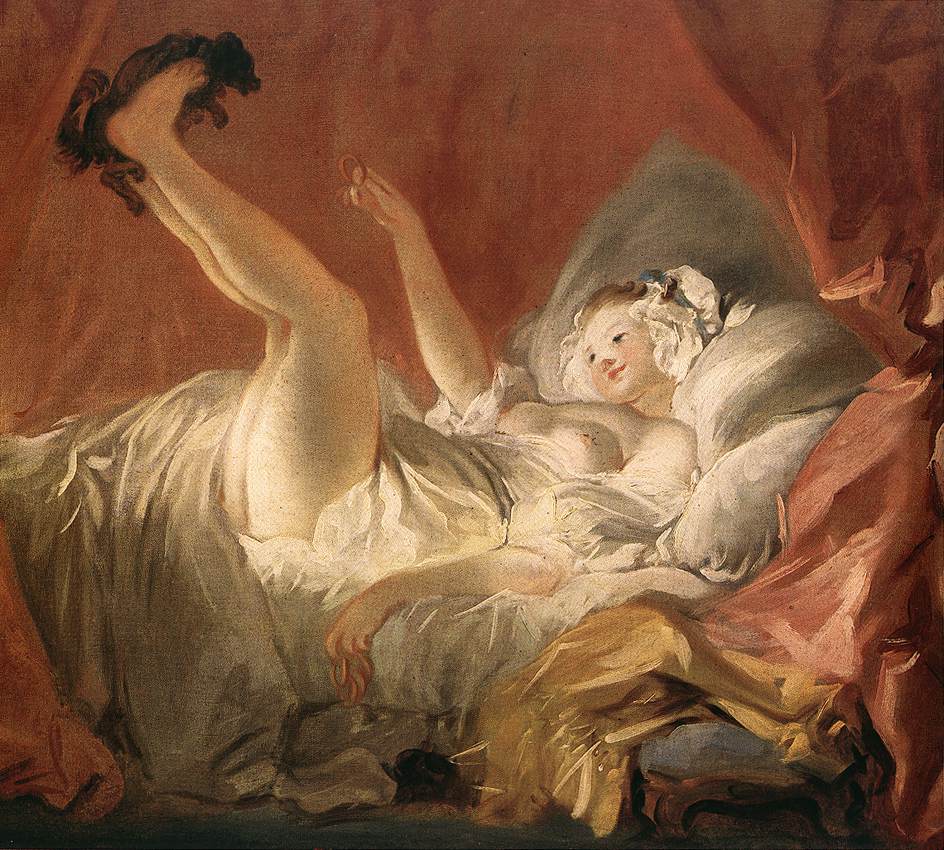
Fragonard. Young Woman Playing with Dog. Read More: http://ann-lauren.blogspot.com/2010/04/18-19th-cent-jean-honore-fragonard.html
Richard Helpern:To be more specific: the “potentially disturbing” materials Rockwell offers to view are often sexual in nature, even perverse. Oddly, when I have run this thesis by friends and acquaintances, some have found the idea completely outlandish and dismissed it instantly, and others have found it so obviously true as hardly to merit discussion. Reactions were about evenly divided between “You’re crazy!” and “Of course!—so what else is new?” Artistic merit is always debatable, but more interesting, I think, is vehement disagreement over basic facts of perception, when one group finds something as plain as day and another finds it both invisible and impossible. Rockwell’s paintings, I’ve found, are able to induce a kind of hysterical blindness in many viewers, who can’t or won’t see what is staring them in the face.Read More: http://www.press.uchicago.edu/Misc/Chicago/314405.html a
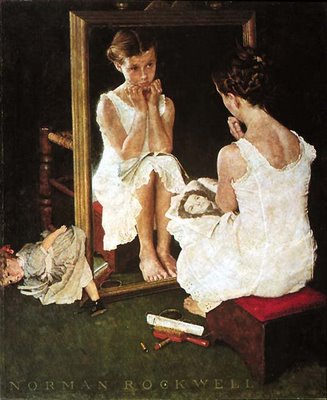
"But when she started looking through Rockwell’s work to find a useful starting point, she began finding clues of a hidden content. Repainting Rockwell’s Girl at Mirror , whom Lacke transforms into a figure out of Balthus, she “found it impossible to render the flesh without sensing the erotic charge that Rockwell must have felt in painting it.” “I suddenly realized,” she said, “that the paintings are already pornographic, and that only the slightest changes were needed to bring this out.” Instead of doing one on a lark, she undertook a series. Brilliantly, she signed one by condensing the famed “Norman Rockwell” signature into the word “Normal.” In a sense, my whole argument is summed up in that one gesture: the containment of the perverse under the sign of the normal." Read More: http://www.press.uchicago.edu/Misc/Chicago/314405.html





 COMMENTS
COMMENTS